Last Updated on: 27th December 2024, 09:12 am
Uplistsikhe is as fascinating to visit as it is difficult to pronounce. The ancient cave city may be as old as 3,000 years, and it long served as a major religious center of pre-Christian Georgia. It then continued to thrive for nearly a millennium after the country’s conversion, ultimately meeting its demise at the hands of the Mongols in the 13th century. While today, there are only a few remnants of the city’s former structures, Uplistsikhe’s unique caves and stunning surroundings make it one of Georgia’s must-visit destinations.
Uplistsikhe translates to ‘Fortress of Uplos,’ in reference to the son of Mtskhetos, after which the former Georgian capital of Mtskheta was named. According to legend, Georgians are descendants of Mtskhetos, who in turn was a descendant of Noah.
While numerous early kings considered themselves close relatives of Uplos, Georgian royalty wouldn’t inhabit Uplistsikhe until the 7th century. The strategic location made for a safe refuge following the Arab takeover of Tbilisi.
Today, except for a surviving church, relatively little is known about Uplistsikhe’s individual structures and what each one was used for. But throughout the complex, which can be explored over the course of a few hours, one can find former temples, wineries, a theater, fortress walls and even a secret escape tunnel.

Entering Uplistsikhe
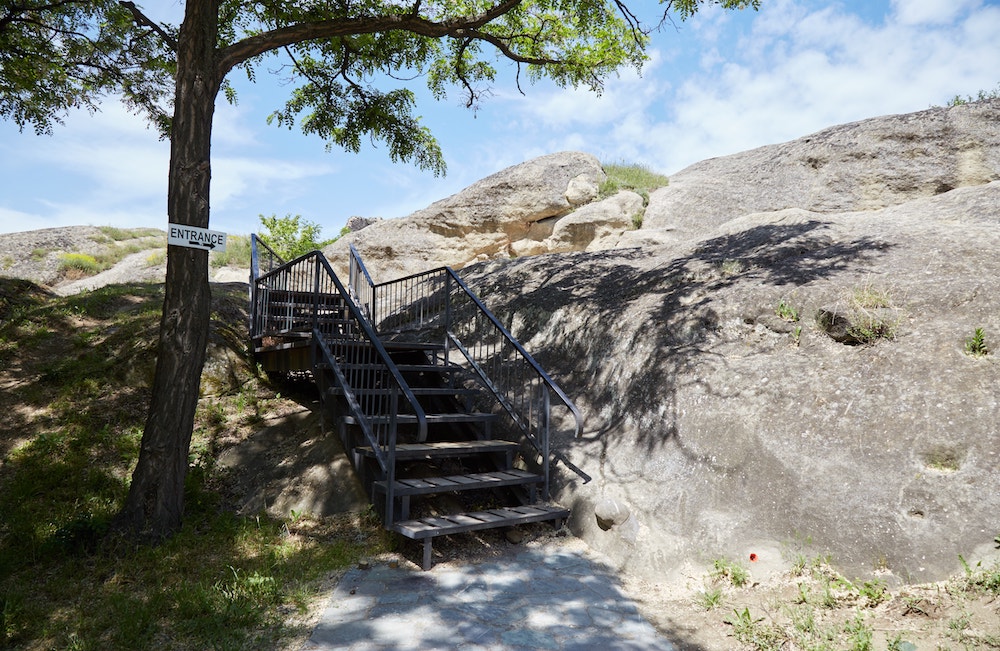
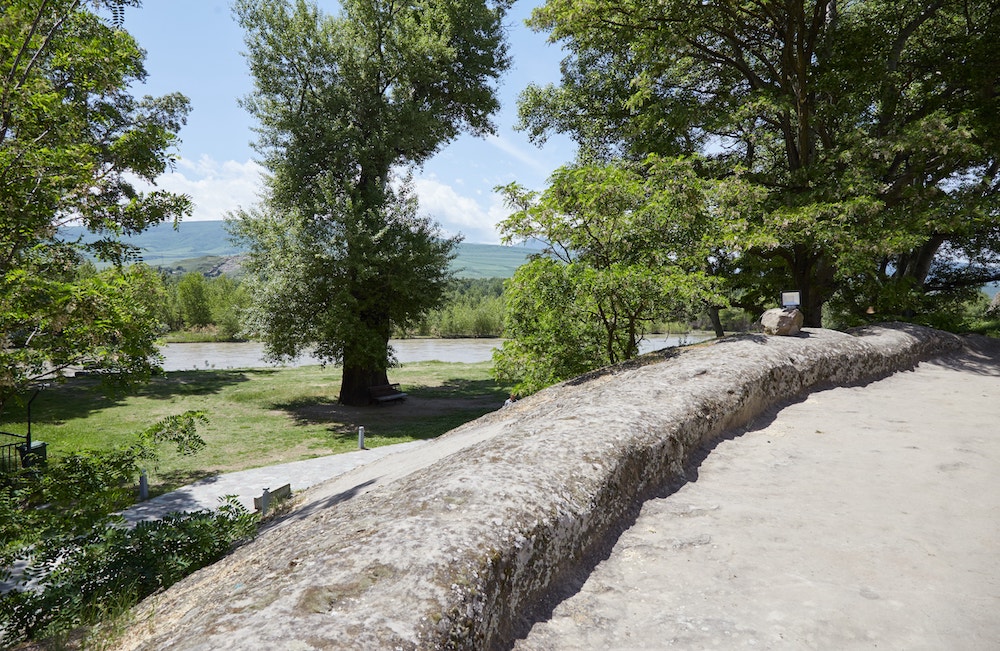
After paying the 7 GEL entry fee, I walked up to the main entrance at the southeast corner of the giant rock. I got a clear view of the Mtkvari River before the path twisted around, taking me up another flight of stairs.
The entire site, supposedly, takes up an area of around 40,000 square meters. The farther away I got from the ticket gate, the more I started to feel as if I was entering another world.
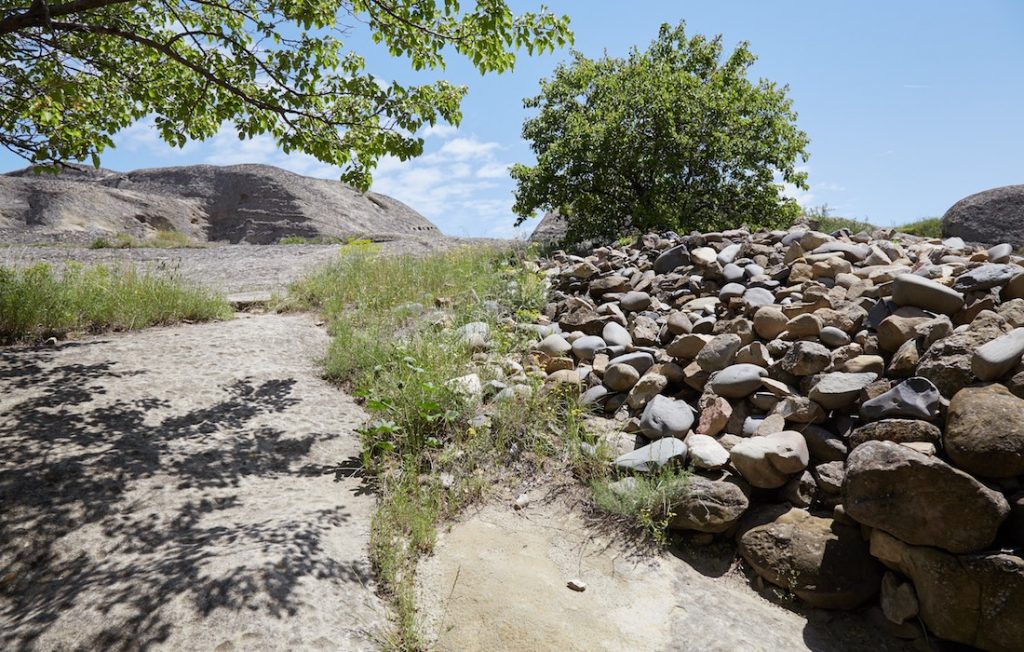

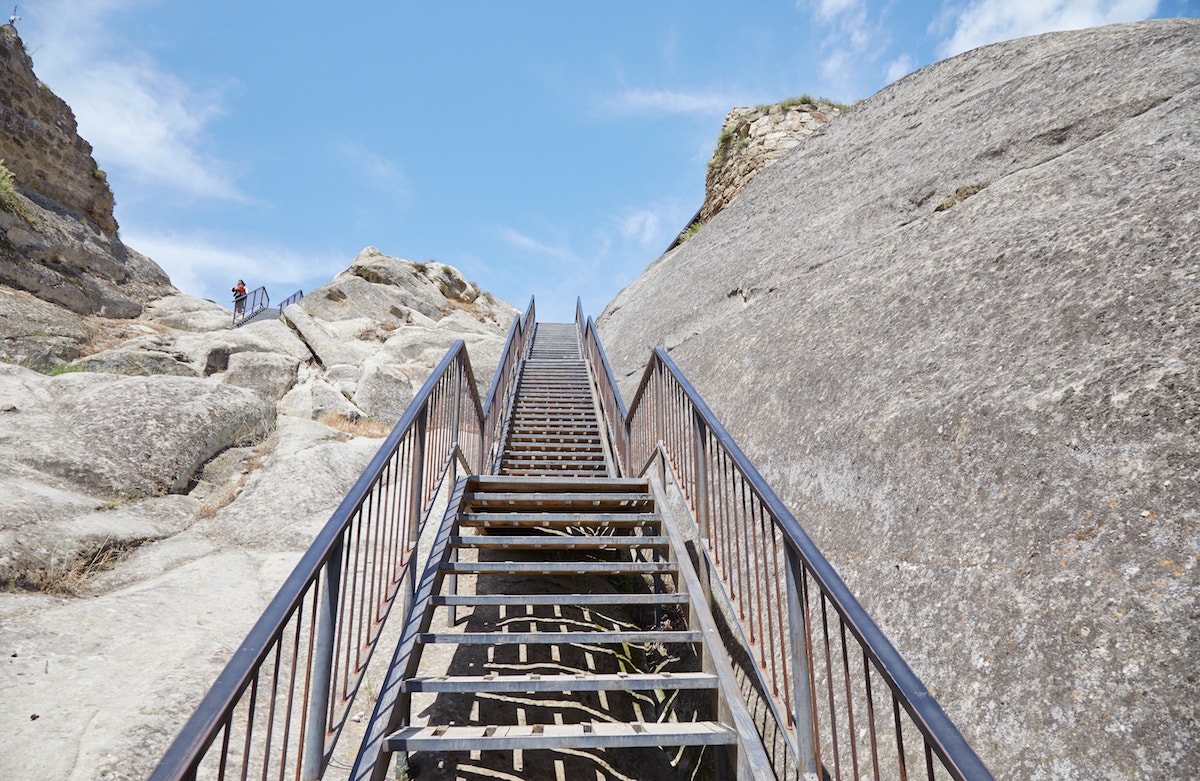



Near the top, I could see various remnants of Uplistsikhe’s ancient defensive walls. While they likely served their purpose well for centuries, they were ultimately no match for the Mongols.
At its peak, Uplistsikhe is estimated to have been home to 20,000 residents. Most of them, however, probably lived down below at the base of the rock. The area which visitors visit today would’ve been the holy city’s inner sanctum.



Looking down, I could see where local residents had painstakingly carved paths in the stone. Some seemed to be for walking, while others were likely devised as runoff for water from heavy rains.
Next, I encountered some manmade caves, along with more portions of the ancient fortress. As mentioned above, the true function of many of Uplistsikhe’s caves and pits remain a mystery to archaeologists. But using your imagination is a big part of the fun when visiting Uplistsikhe.
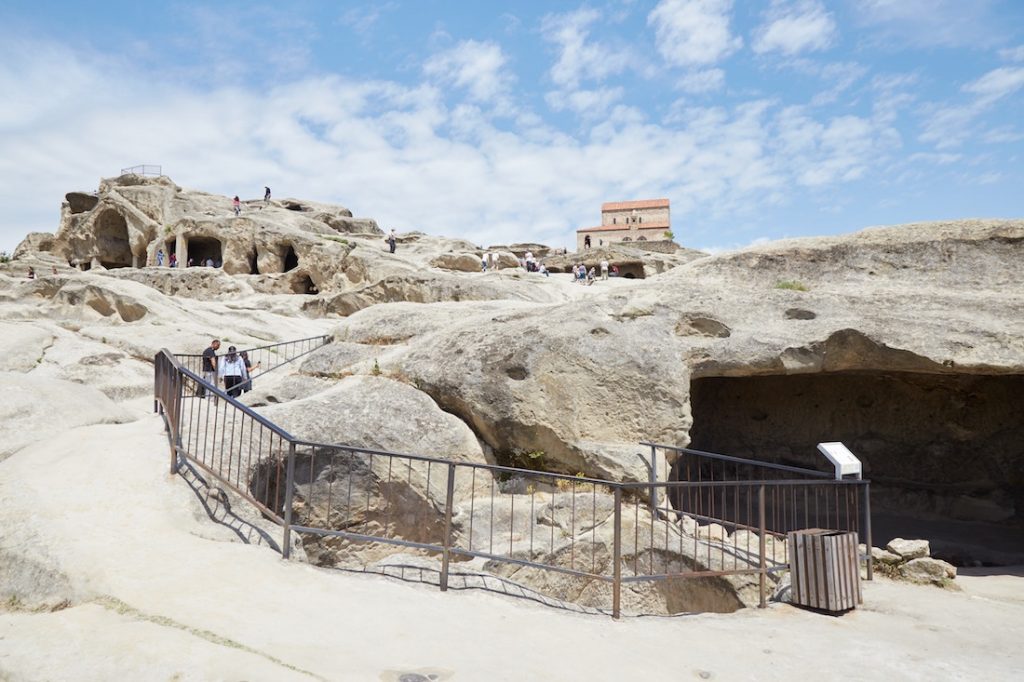
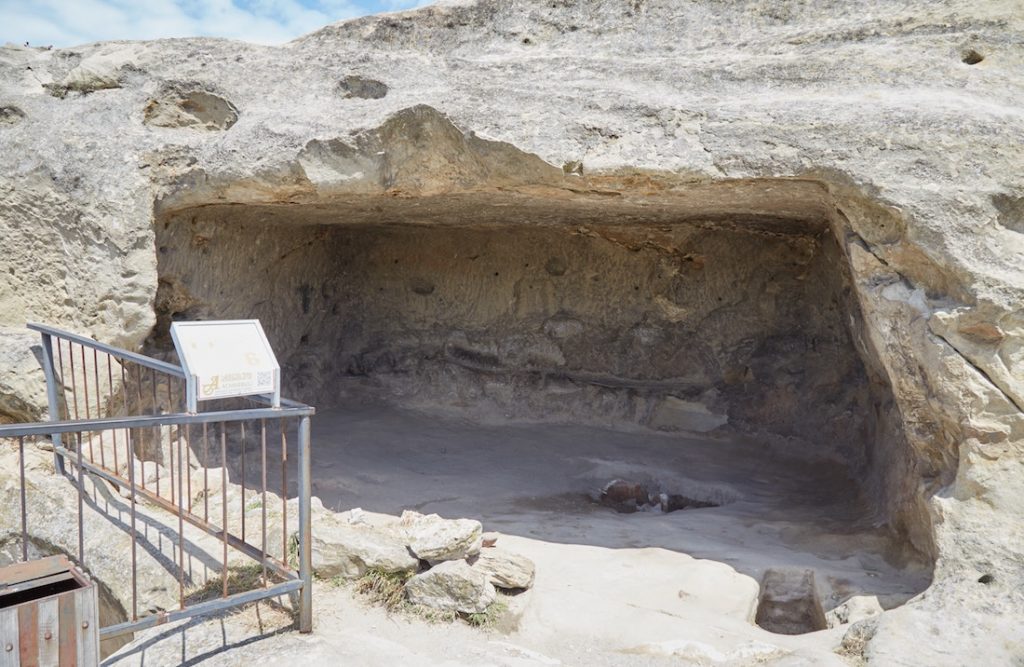
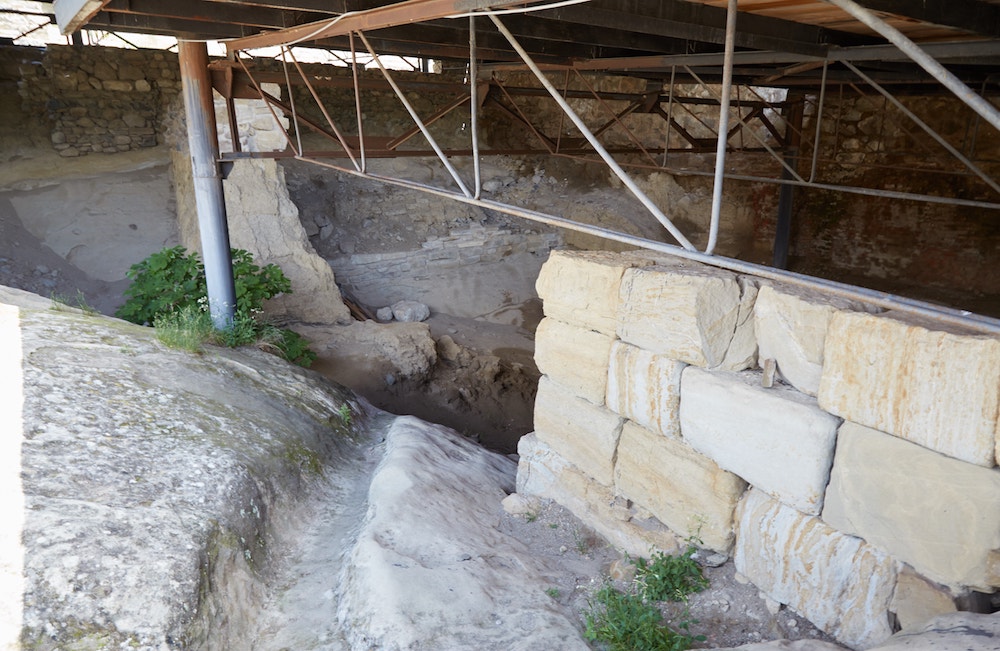

Temple of Makvliani
Though there are numbered signs spread all throughout the complex (without any additional information, sadly) I opted for a different strategy. Rather than follow the signs in order, my main priority was to avoid the tour groups. Over to my right, I saw a large assortment of cave rooms that happened to be void of any other visitors, and so I went to take advantage of the opportunity.
The area, known as the Temple of Makvliani, is believed to have been Uplistsikhe’s prominent pagan worship center in the days before Christianity.

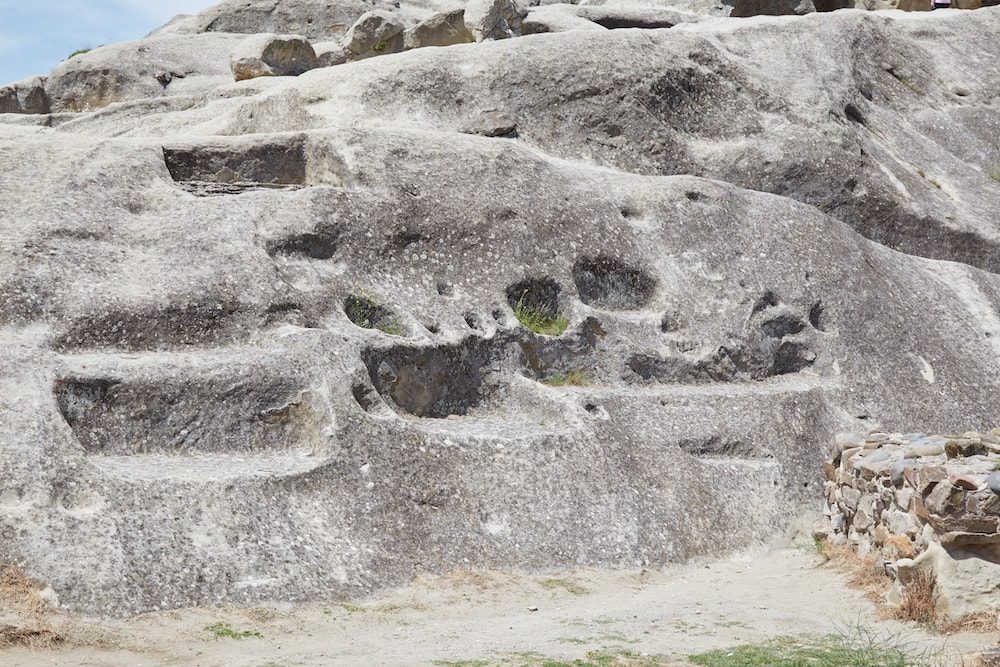

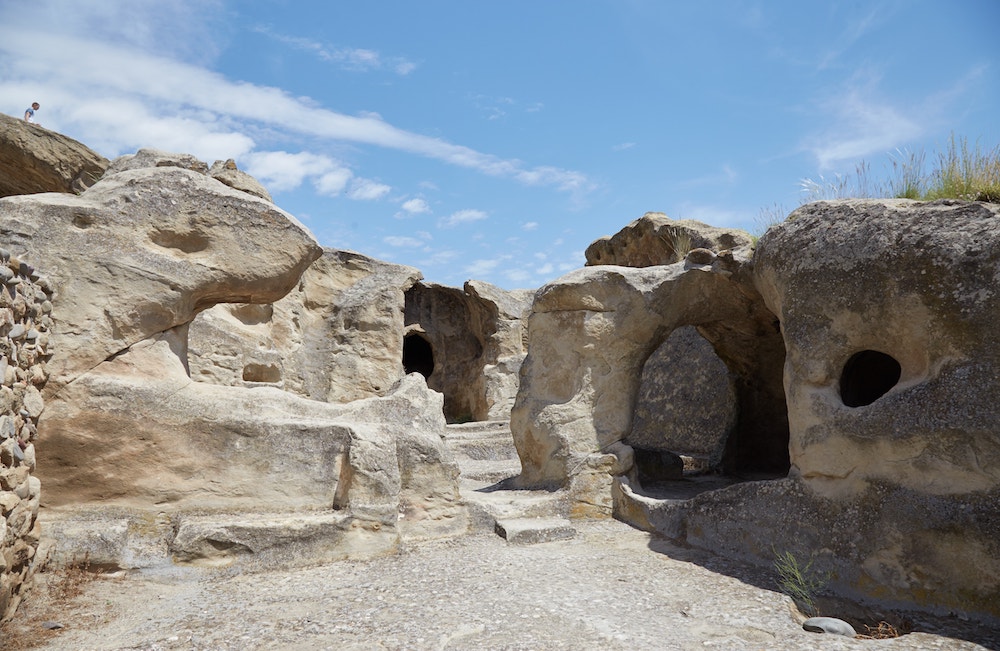
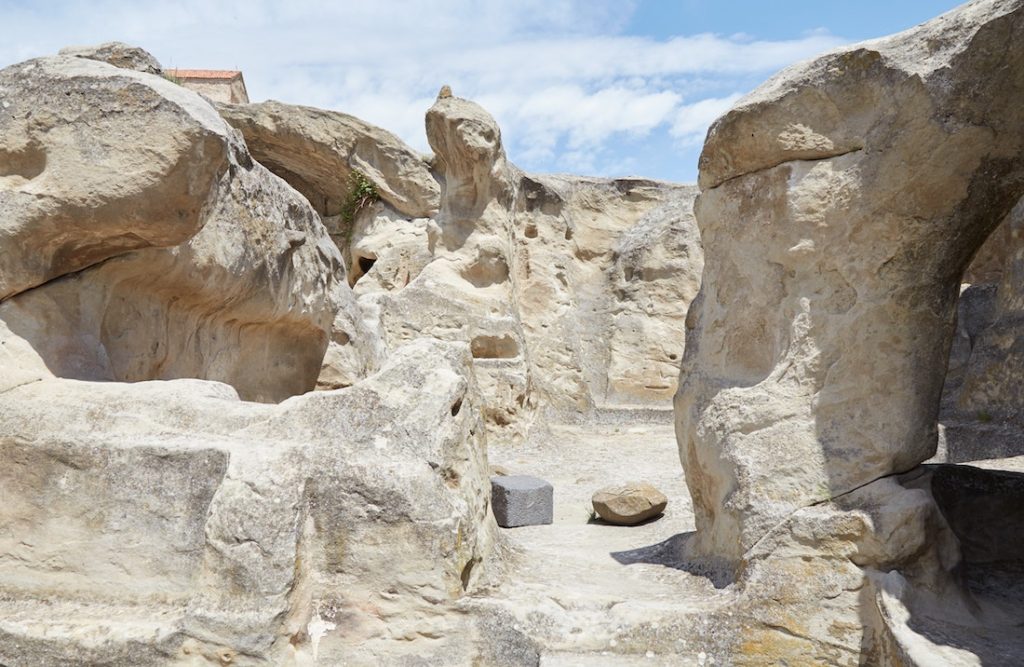

The spacious temple consists of many rooms and chambers. In addition to areas carved out of the stone, additional brick walls were also added. While we know very little about what the rituals here were like, this was likely a place of worship for the Caucasian Sun goddess.
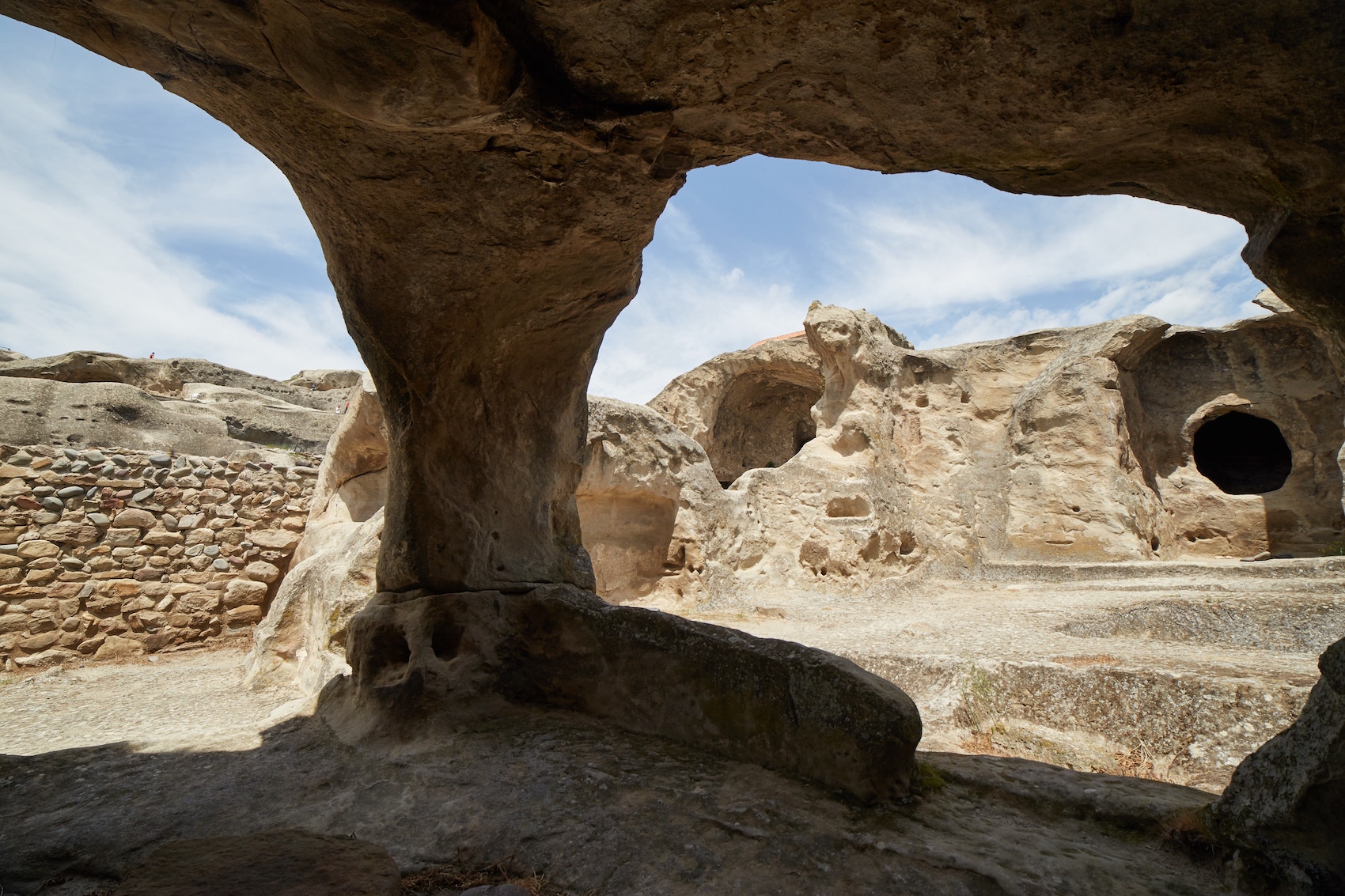
Passing through a series of rooms, I encountered the area furthest from the entrance. Given my experience at other temples around the world, and seeing how they often share a lot in common, I guessed that this section would’ve been restricted to just the high priests.
The main chamber was a large cave carved from the natural rock, and it’s likely here that some sort of altar would’ve been placed.




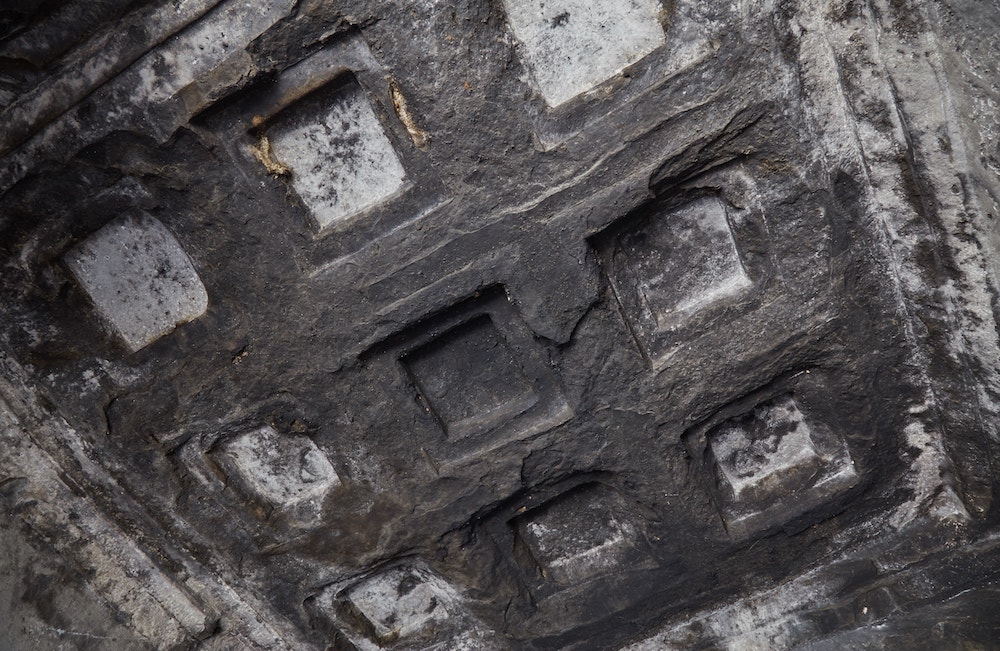
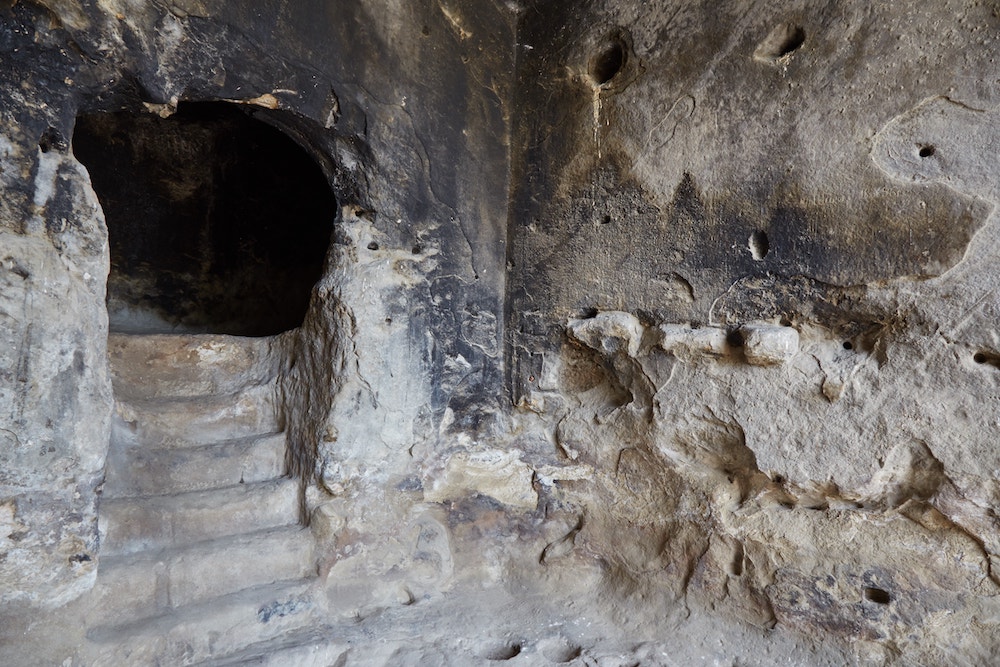
Today, no evidence of an altar remains, except for a small circular pit in the ground, preceded by what seems to be a drainage canal. This was possibly to let out holy water poured over the temple’s main image. Or perhaps the blood of sacrificed animals!
The area’s name Makvliani provides us with no additional clues as to what took place here. The word translates to ‘blackberry,’ named after the vines which dangle from the ceiling.
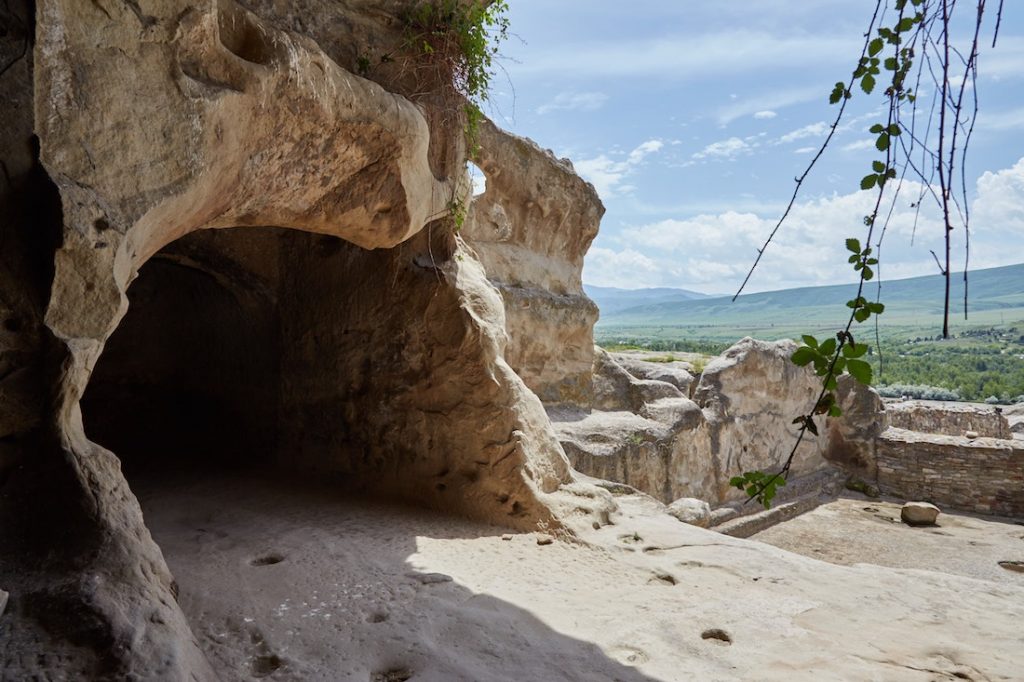
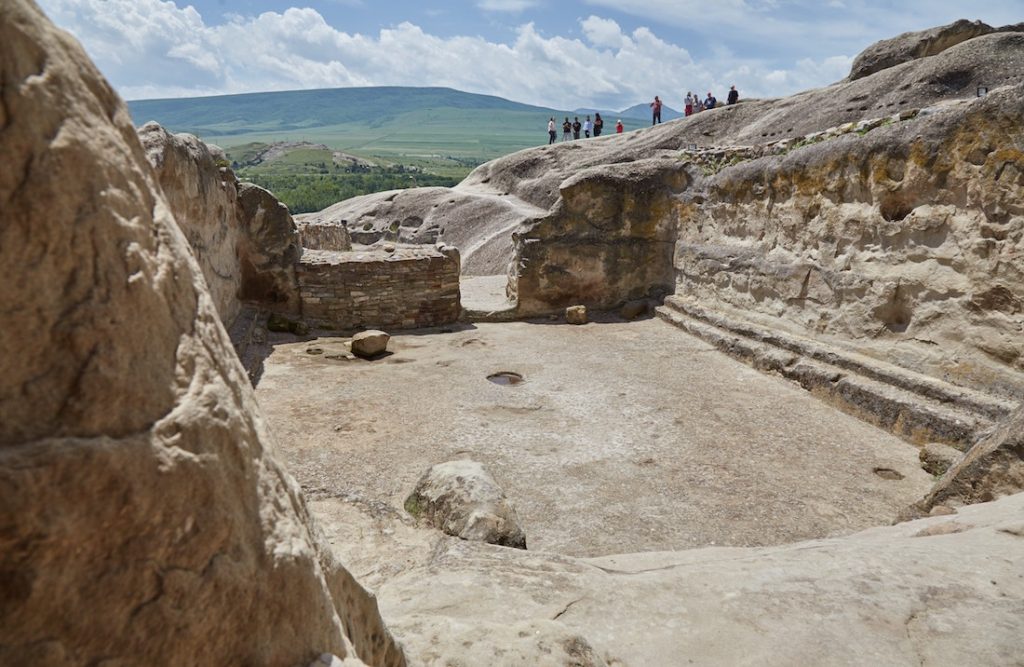

The 'Theater'
Next, I made my way over to the structure commonly referred to as the ‘theater.’ It’s easily recognizable for its triangular roof and columns, which are now crude concrete replacements of whatever once stood here originally. Clearly, it’s much too small for a major theatrical performance. So what was it used for?

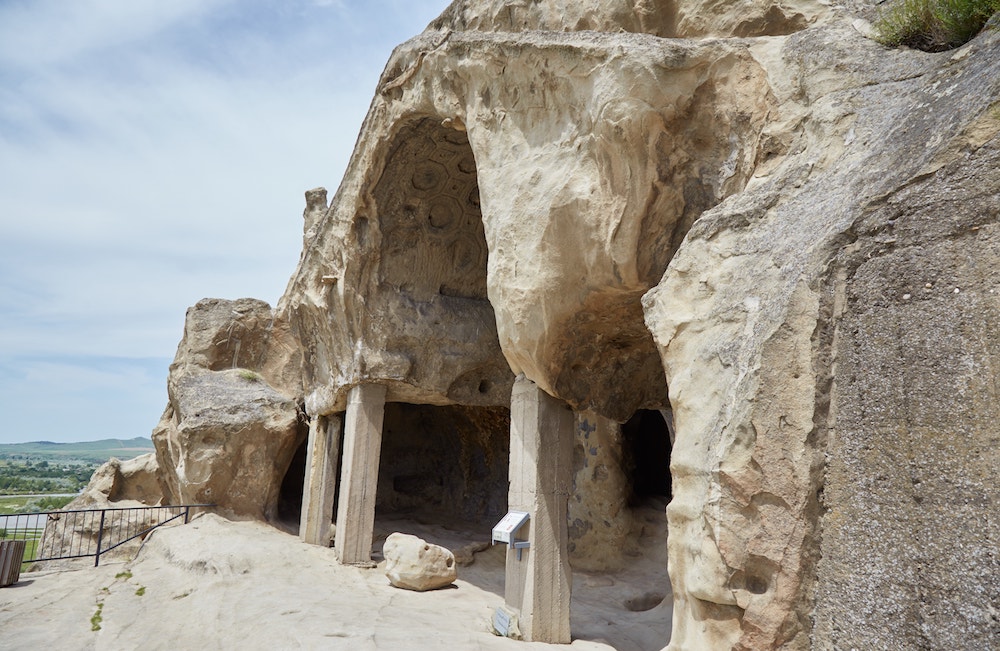
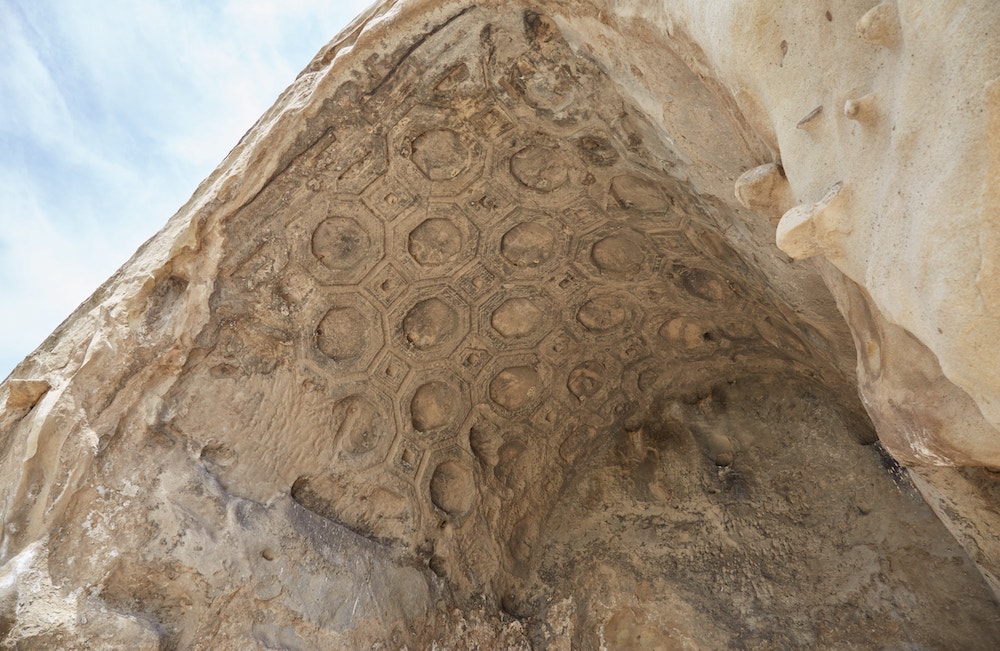
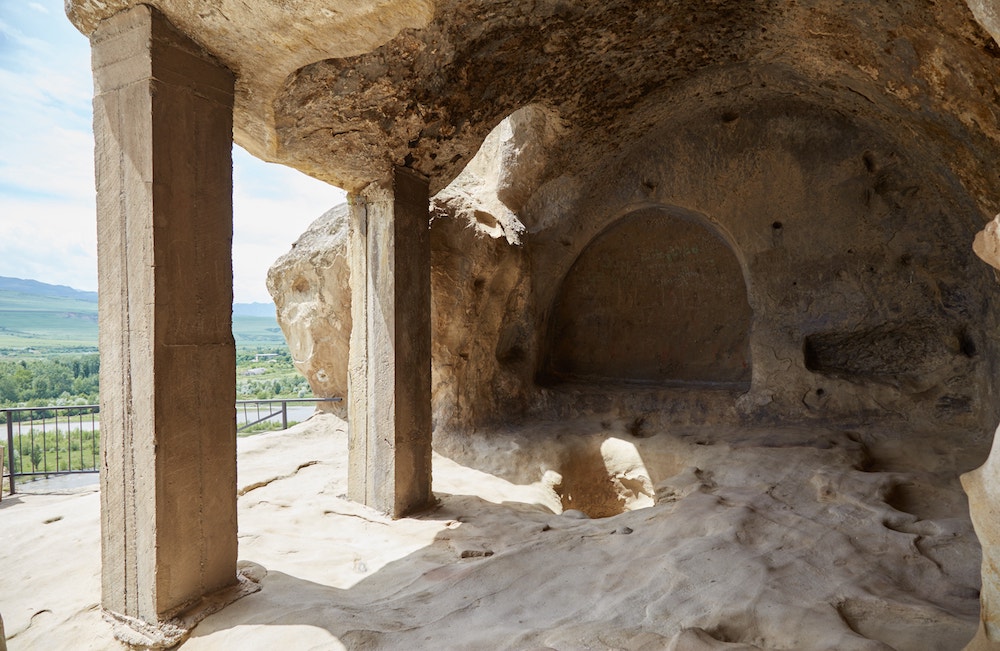
Like many other structures atop the giant rock, this was also likely a temple of some sort. Experts believe that it could be as old as the 1st century AD. With that in mind, it’s possible that ritualistic plays were carried out here – ones which were never intended for a large audience.


Visitors can walk in and out of the different rooms, some of which have sadly been vandalized. Turning around, you can also spot the remains of a large structure in front, which may have been a seating area. Also be sure to look up to see the carved patterns under the arch of the entrance.
But the real highlight in the area is what you see by peaking over the edge of the cliff to the north of the theater.
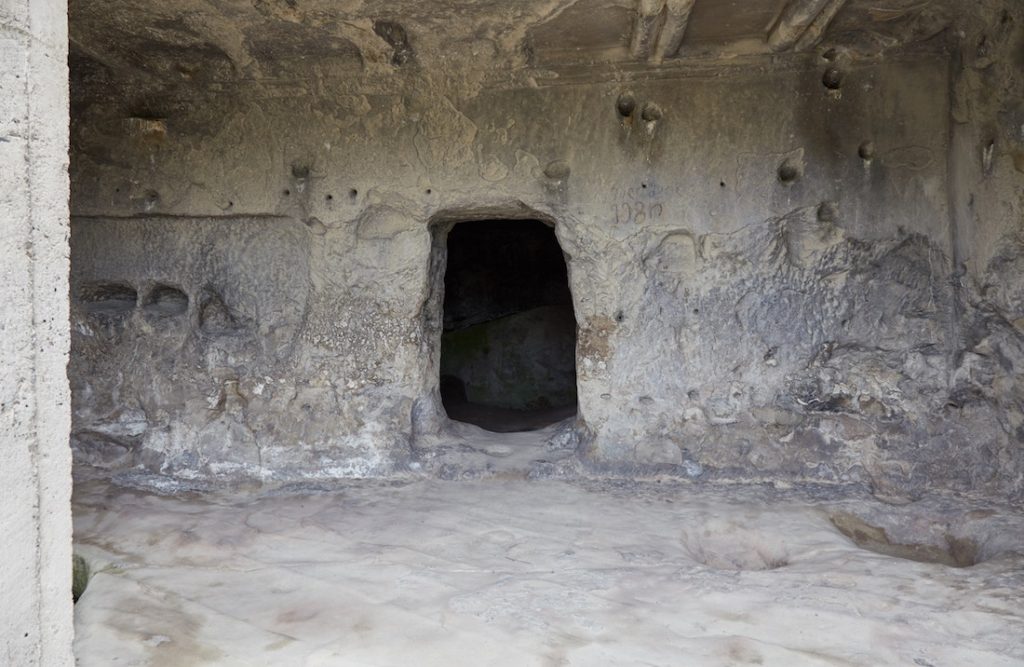

The Abandoned Town
Over in the distance, you can spot the expansive ruins of what is now simply referred to as the ‘abandoned town.’ This likely would’ve been where the average citizen of Uplistsikhe lived, while the priests, royalty and other members of the elite inhabited the large rock.
At the time of writing, the abandoned town doesn’t seem open as a tourist attraction, but it looks like a fun place to explore.


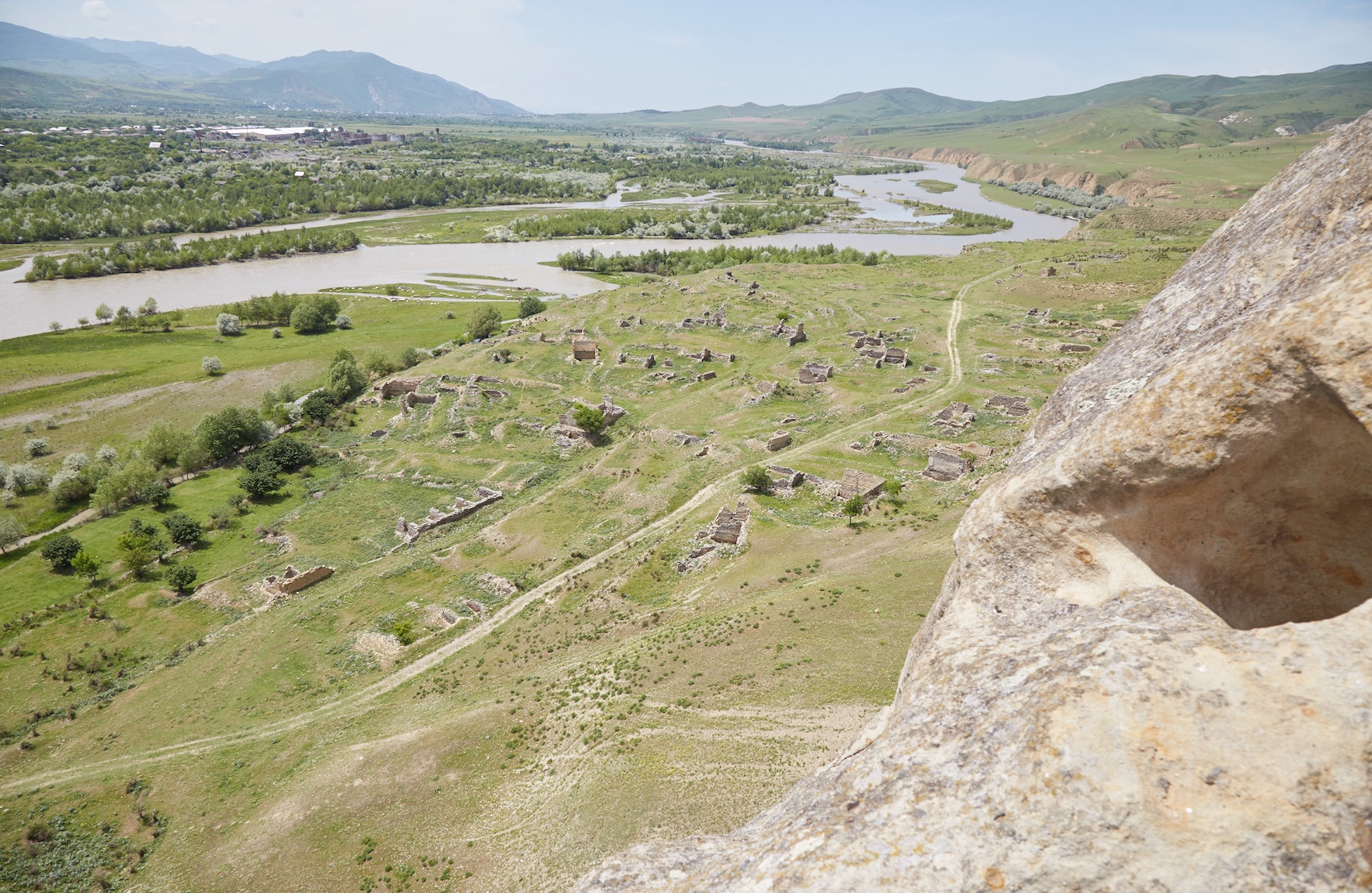
Queen Tamar's Hall
Queen Tamar is one of Georgia’s most beloved historical figures. Though a queen, she actually ruled as a king in the 12th-13th centuries. Her reign is now widely considered to be one of Georgia’s most prosperous eras. Confusingly, however, Queen Tamar never lived in Uplistsikhe.
Tamar, did, however, reside at one of Georiga’s other prominent cave cities, Vardzia. The resemblance to her former room at Vardzia is perhaps why this cave has been named after her. But the misleading title does nothing but confuse visitors wanting to learn more about Georgian history.
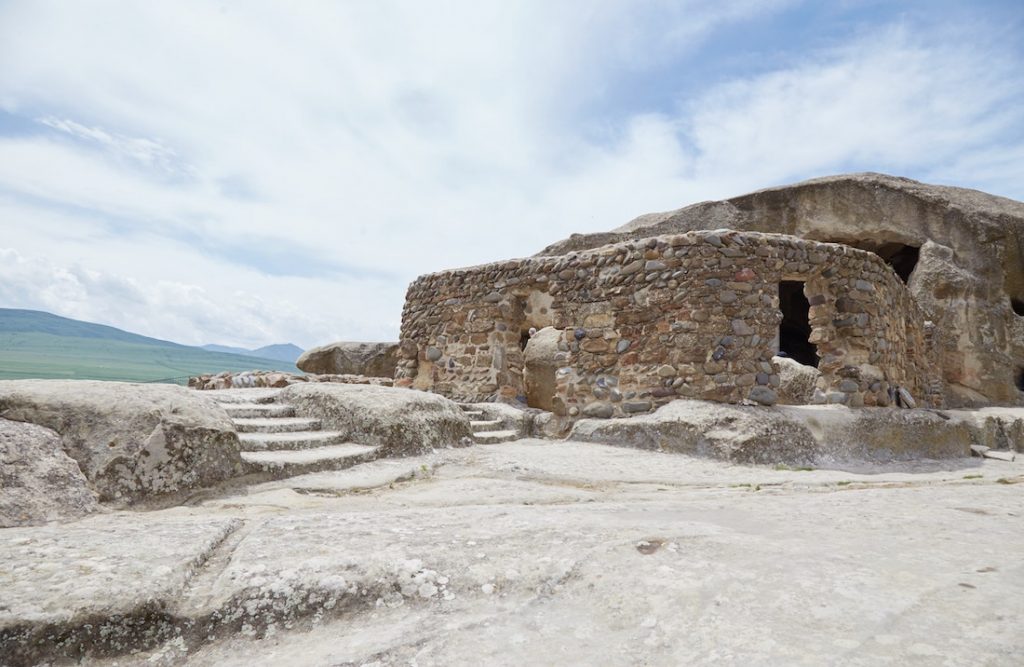

Situated behind a fairly well-preserved rounded wall, Queen Tamar’s Hall is the largest cave at Uplistsikhe. And it’s also the most intricately decorated. The main room features a set of three distinct arches, while you can find two additional rooms on either side.
Like the other main structures at Uplistsikhe, scholars suspect that this was once a pagan temple.
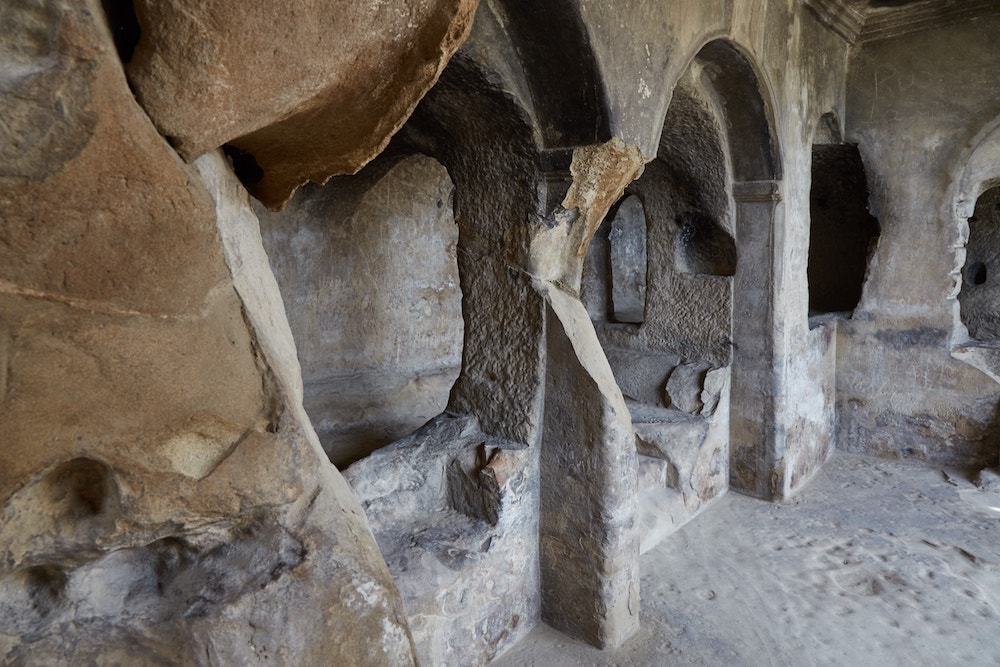



Uplistsikhe was also a place for wine production. There are no less than three areas with pits used for winemaking within the complex, with one of them being just outside Queen Tamar’s Hall.
Furthermore, don’t miss the ‘Apothecary,’ a former storage place for medicine. It’s hard to miss the layers of cubes where archaeologists have discovered traces of medicinal herbs.

The Prince Church
Surely, by this point, you’ve noticed the Prince Church in the distance, as the building doesn’t quite fit in with its surroundings. But first, you can find yet another set of cave halls beneath it with are worth a quick glance. Today, the area is simply referred to as the ‘Long Temple.’
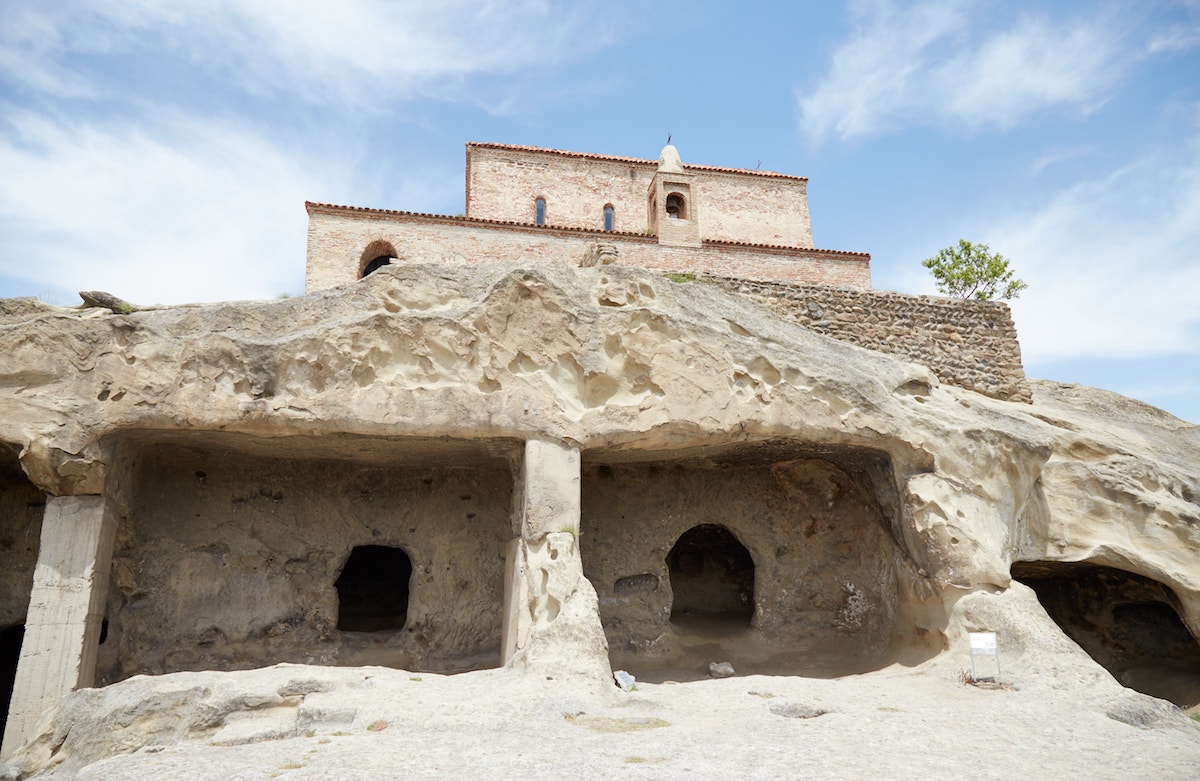

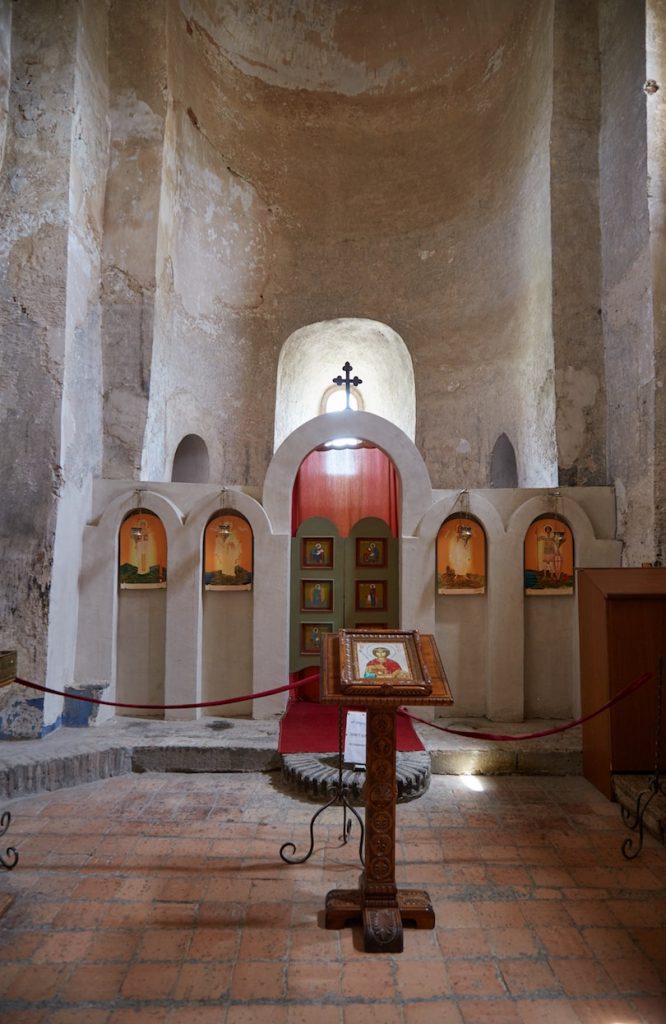

The church, which dates back to the 9th or 10th centuries, was amazingly one of the only structures to have survived the Mongol invasion. Or rather, the Mongols chose to spare it despite killing thousands of monks. It’s unclear why, but perhaps they made this their base of operations during the onslaught.
Considering Uplistsikhe’s pagan past, there surely would’ve been a prominent temple here before Georgia’s conversion to Christianity. It’s staggering how many churches throughout the Caucasus region were in fact built over the ruins of demolished temples.
Various Halls

Beyond the main highlights, I was delighted to find plenty more caves to explore. One of the caves is believed to have been a former temple dedicated to the local Sun goddess and later transformed into a Christian basilica.
While the true function of most of these caves remain a mystery, it’s still fun to take a peek inside, or even use them as refuge from the midday heat.

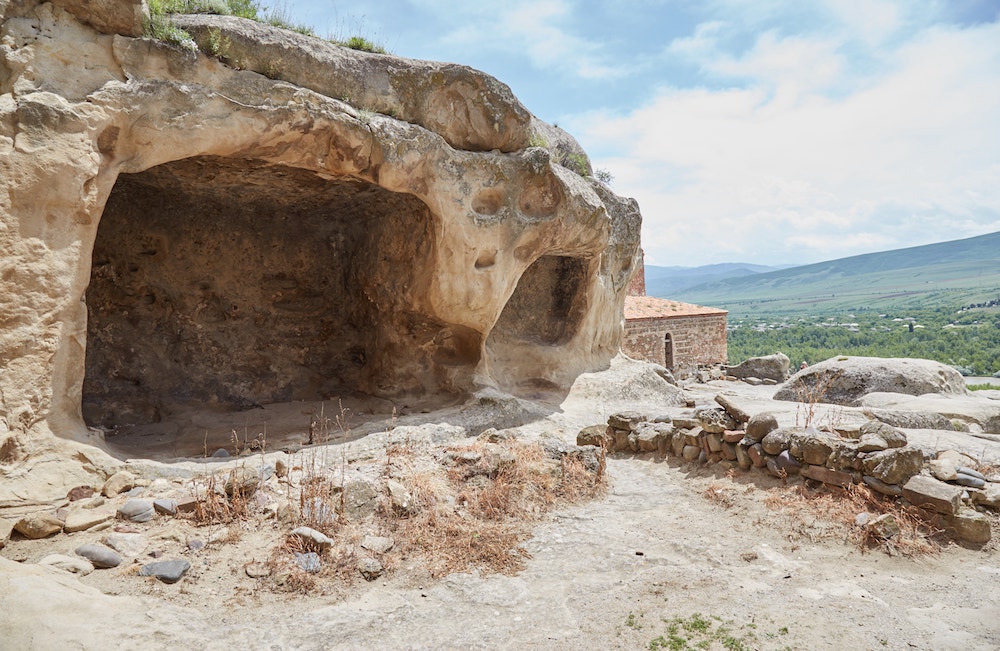

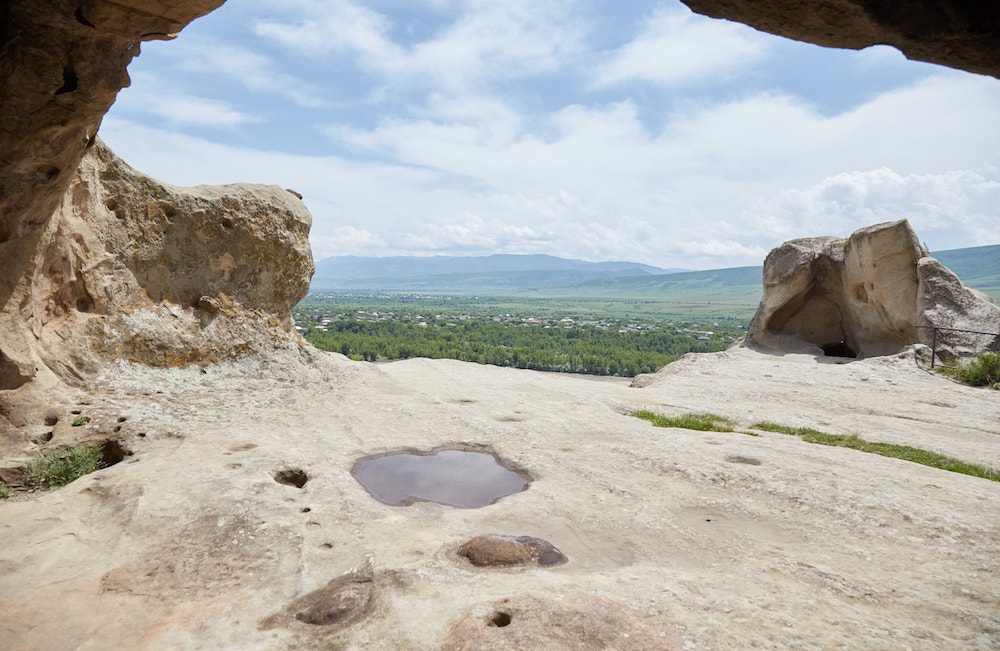
If you still have some energy, it’s also possible to walk a fair distance up the rock. You can find even more evidence of the former defensive walls that would’ve surrounded Uplistsikhe.
And the higher vantage point offers even better views of Uplistsikhe’s gorgeous surroundings. While another of Georgia’s ‘cave towns,’ the David Gareja Cave Monastery, is widely lauded for its breathtaking scenery, Uplistsikhe is not far behind in that department.

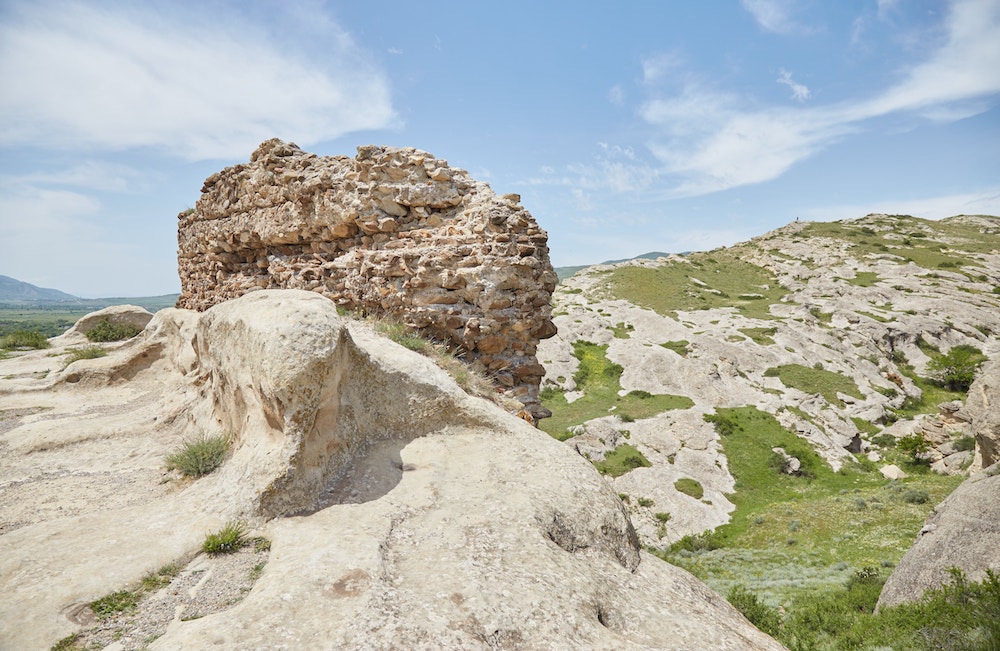

Looking off into the distance, I could even see a couple of visitors making their way to the very top of the mountain! But I’d already spent much more time than expected at Uplistsikhe, and I wasn’t up for the additional challenge.
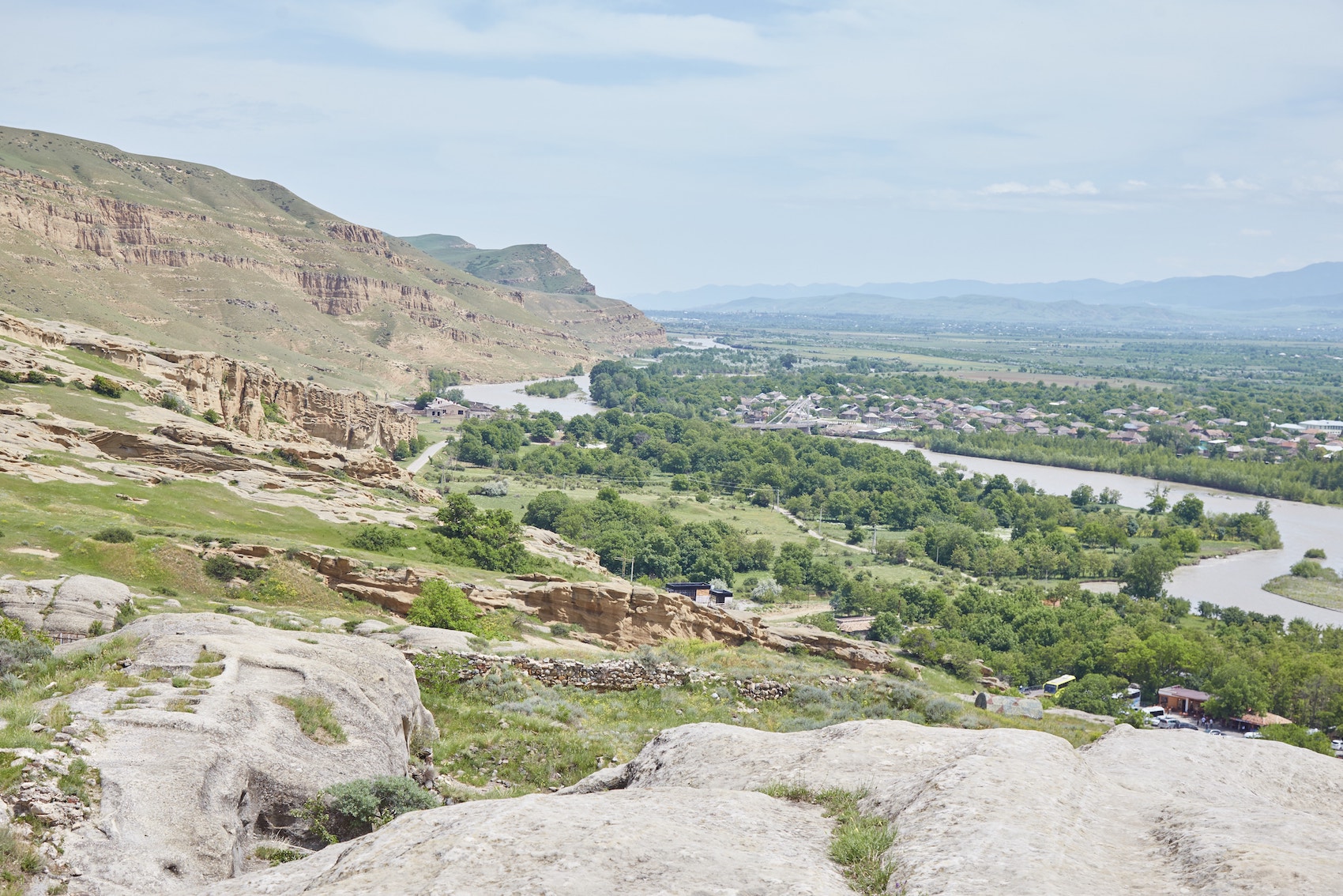
Heading Home

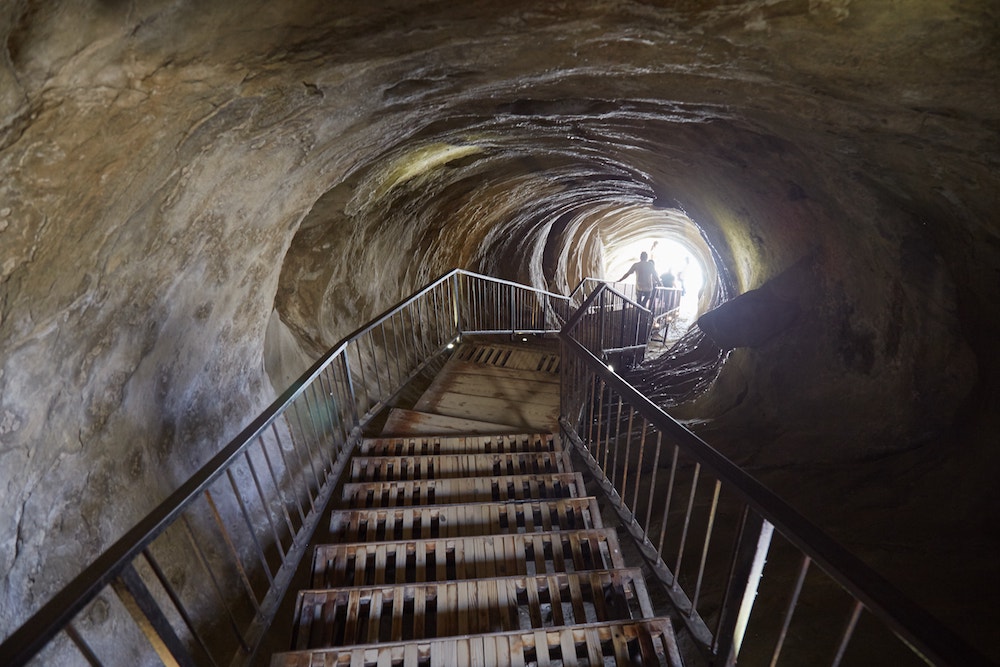
Leaving Uplistsikhe, there was one more surprise in store. Instead of the same staircase found at the entrance, visitors can walk out through the secret escape tunnel once used by the town’s elite residents. This large, long tunnel must’ve taken an especially long time to carve out from the rock.
There’s now a modern staircase which makes the walk down safe and easy. But the idea of sliding out through the cave also seems like a lot of fun.
Back near the entrance, I passed by a museum which was unfortunately closed. Given the lack of information at the site itself, this seems like a good place to learn more about Uplistsikhe’s history. (The museum at Vardzia would also be closed without any explanation during my visit.)
After hours on my feet, I sat down for a tasty meal at the cafe by the entrance. And then I went out to do some more walking, over to the nearest town on the other side of the river. Though I’d arrived in Uplistsikhe by hiring a taxi from Gori (more below), I opted for the marshrutka, or shared minivan, for the way back.
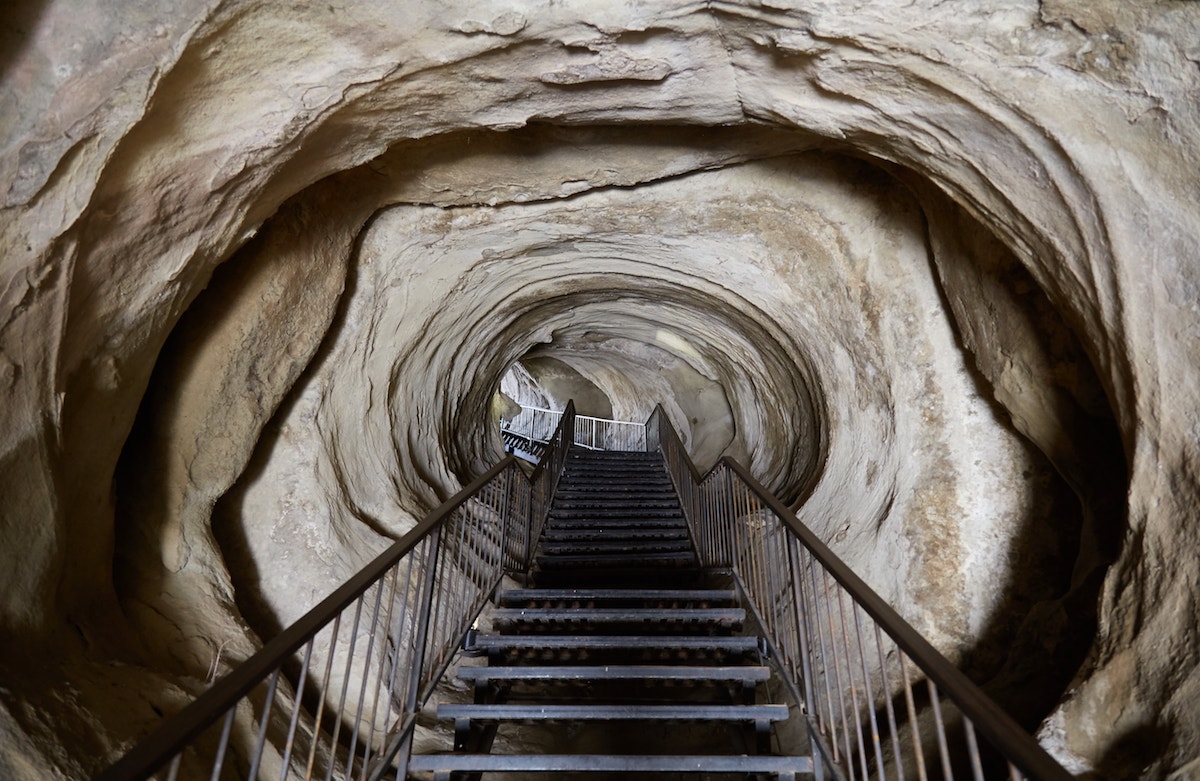
The walk back is worth it for unique rock formations all along the left side of the road. I found myself stopping multiple times to admire the scenery. Eventually, I arrived at the bridge and walked across the river. And somewhere in town, according to my information, I’d be able to find a ride back to Gori.



Before my visit, I looked up info on the return trip to Gori on three or four different web sites. And sure enough, each one provided different instructions! The basic idea, though, was to find some kind of bus stop along the town’s main road.
But I never found it and kept on walking. After fifteen minutes or so of walking through town, I decided to turn around. Surely, I had missed something. Arriving back where I started, though, I still couldn’t see anything resembling a bus stop.
Luckily, though, I came across a local man sitting on a bench and asked him ‘Marshrutka, Gori?’ He was headed there too and walked me to the spot. It turns out that I’d already walked past the spot twice! But with zero signage and nobody else waiting there, it was impossible to detect.
Though I’d considered doing a quick tour of Gori, I noticed some heavy clouds forming overhead. I quickly found a bus bound for Tbilisi, hopping on just in time to evade the heavy downpour.
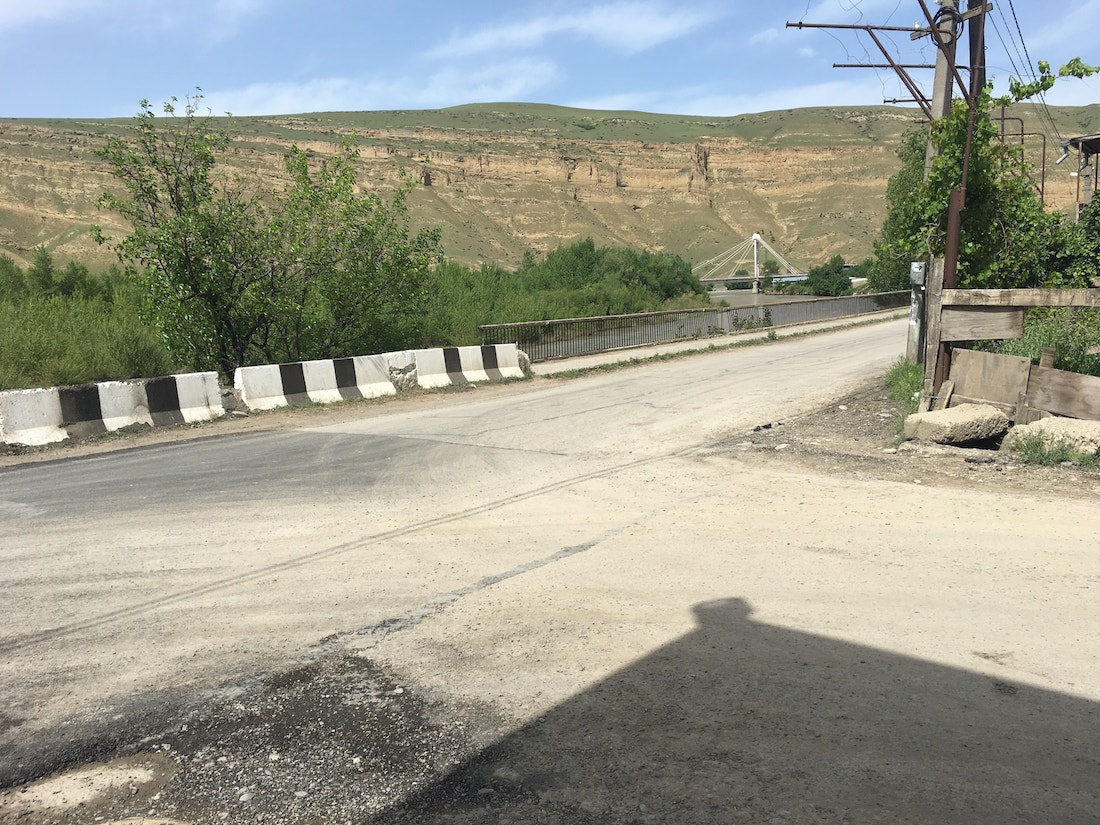
Additional Info
Uplistsikhe can be visited as a day trip from Tbilisi, but not directly. First you will need to get to the city of Gori, which is best known for being the hometown of Joseph Stalin. Gori is about 90 minutes from Tbilisi, and first you’ll need to get to Didube.
Take the metro to Didube station and then follow the crowd to the large bus station/outdoor market hybrid. It’s not really a station, however, but just a bunch of vehicles parked within a huge parking lot.
From Didube to Gori you can either take a marshrutka (minibus) or a shared taxi. Marshrutkas leave hourly and cost 4 GEL. Shared taxis only cost 5 GEL and leave whenever full. Since each taxi can only fit around 5 people, you shouldn’t have to wait very long.
Arriving in Gori, you again have the option of either marshrutka or taxi. Marshrutkas only cost 1 GEL but will drop you off in a nearby village about 15 minutes from Uplistsikhe on foot. Another issue is that taxi drivers will approach you and tell you that no such marshrutka exists. They’re lying, of course. But since Gori’s bus ‘station’ is also a large, crowded parking lot with no signage, it’s not clear where the marshrutkas leave from.
Though I’d planned to find the marshrutka, I happened to meet two other travelers in the parking lot and we ended up splitting a taxi. As we all hoped to take our time at the site, we opted for a one-way journey which cost us 15 GEL. We could’ve probably bargained harder, but it ended up just being 5 per person.
Many people pay for a taxi driver to wait for them and take them back, but this means you’ll have to rush once there.
As mentioned above, I opted for the marshrutka back to Gori, but I didn’t have an easy time finding it. If you plan to take one back, be sure to ask a local who can point you in the right direction, as there are no signs or time tables posted anywhere. Hopefully, the picture above can give you somewhat of an idea of where to wait.
Though located in the Kakheti region, most visit the David Gareja Cave Monastery as a day trip from Tbilisi. Despite Georgia being such a small country, Tbilisi is a bigger city than most would expect, and visitors have a number of neighborhoods to choose from within the city center.
Many tourists choose to stay in the ‘Old Tbilisi’ area, and for good reason. This area is home to many prominent landmarks like the Turkish baths, Rezo Gabriadze Marionette Theater, Narikala Fortress and the Botanical Gardens. You can also walk across the river to access Sameba Cathedral (located in Avlabari, another interesting area), while Liberty Square is a short walk to the north.
Many visitors also base themselves near Liberty Square and along Rustaveli Avenue. This area would also give you access to some of Tbilisi’s most notable architecture, such as the Parliament Building, along with numerous museums. Furthermore, the bus to David Gareja departs from Pushkin Square, just next to Liberty Square.
Further north, on the eastern side of the river, Marjanishvili is another popular area. From here you can easily walk to Agmashenebeli Avenue, known for its architecture and restaurants. Also nearby is Fabrika, a unique multipurpose space which features a hostel, art spaces, bars and restaurants.
An increasing number of visitors are also basing themselves in the city longer term. In that case you should also consider the Vera and Saburtalo neighborhoods.
For whatever reason, many Tbilisi residents recommend the Vake district, but I would advise against staying there. While it may have some trendy cafes and Vake Park, it’s the one neighborhood in central Tbilisi with no metro access. Furthermore, the neighborhood is very hilly with an atrocious traffic problem (even by Tbilisi standards!). Off the main streets, there are few traffic lights or underpasses, while entire sidewalks are often blocked by parked cars. With all that considered, it’s best to stick to one of the other neighborhoods mentioned above instead.
Strangely, the ancient rock city seems to get mixed reviews, with a number of comments online describing it merely as a pass-through destination. Furthermore, numerous blog posts I came across mention Uplistsikhe as if it were merely something to do as a side trip from Gori, best known as Joseph Stalin’s hometown.
But don’t let these comments mislead you. While we may not know a whole lot about it, Uplistsikhe is definitely one of Georgia’s unmissable destinations. The interesting backstory combined with the beautiful scenery and unique cave formations combine to make this one of Georgia’s top day trips. And I’d even consider it my favorite over Georgia’s other ‘cave towns’ like David Gareja and Vardzia, though I certainly enjoyed those as well.
It seems like many visitors rush through the site, only taking a few minutes to see each highlight. As a result, they miss many of the more interesting smaller caves along with the best vantage points from which to appreciate the scenery.
If you have the slightest interest in archaeology or natural scenery, make Uplistsikhe the main objective of your day. I’d only recommend exploring Gori (an odd town where people still revere Stalin as a national hero) if you have some extra time.

Pin It!

Thank you for providing such detailed descriptions of the elements of the city. It was immensely helpful! Loved the photos too!
Thanks for reading!